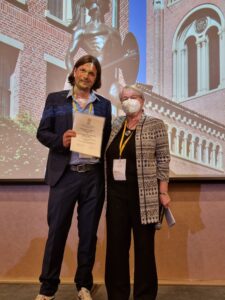

The Dibner Award for Excellence in Museum Exhibits was established in 1985, through the generosity of Bern Dibner, to recognize excellence in museums and museum exhibits that interpret the history of technology, industry, and engineering to the general public. The award consists of a plaque and up to $1,000 to cover expenses for a member of the design team to accept the award at the SHOT awards banquet.

Stefan Krebs (left), Recipient of the 2023 Dibner Award for Excellence in Museum Exhibits, and SHOT Vice-President Debbie Douglas in Los Angeles. (Photo SHOT)
Luxembourg Centre for Contemporary and Digital History, University of Luxembourg
For: Minett Stories: Remixing Industrial Pasts in the Digital Age
Minett Stories: Remixing Industrial Pasts in the Digital Age is an online exhibit focused on the history and identity of the industrial southern region of Luxembourg known as the Minett. The exhibit features twenty-one interrelated vignettes revealing diverse facets of the region’s history, which has been heavily influenced by iron and steel production and the mining of “minette” iron ore, which lends the region its name. The Luxembourg Centre for Contemporary and Digital History launched the exhibit in 2022 as a unit of a larger “Remixing Industrial Pasts in the Digital Age” project funded by the nonprofit European Capital of Culture Esch2022.
Minett Stories connects the History of Technology intimately with cultural and social history by tracing transformations in landscapes, places, and people shaped by rapid industrialization, followed by equally rapid deindustrialization, and constant shifts in technologies, infrastructures, and population from the late 19th century to the 1970s. The exhibit illustrates with examples and personal reflections how these changes impacted both social groups and individuals, with emphasis on workers and families as inhabitants, and how the industrial character of the region has shaped its culture and identity up until today. Such an approach establishes an emotional connection with the audience, making for engaging storytelling. The presentation also affords people who may have little knowledge of the area an opportunity to understand its character and offers those who know the Minett a way to appreciate their surroundings through a multilayered tapestry of historical interpretation.
The exhibit’s online interface is intuitive and simple to navigate visually without instruction, and it comprises a wealth of digital history content—imagery, film, audio, text, interview, radio drama, graphic novels, computer-aided visual enhancements—that together weave a rich interpretive fabric approachable by many audiences. The seamless integration of digital collections enhances their value and impact taken together as a whole. The exhibit’s user path is not linear but instead offers many choices simultaneously, making maximum use of the viewer’s freedom to explore, repeat, and compare. The presentation’s muted palette of sepia, blue, green, and gray with shaped buttons reminiscent of natural ore features is appropriate to the content. Text features are well-presented in sans-serif fonts against good backgrounds for readers of all abilities, and scrolling and forward-backward features afford the user easy control of their journey through the Minett’s history and culture. The exhibit’s multilingual nature (English, French, German) expands its audience across cultures and continents.
The Dibner committee was impressed by the team’s accomplishment in distilling a large and varied collection of digital assets into a succinct yet detailed online presentation that has both historical and emotional resonance. The essence of the social-historical lens through which the History of Technology is portrayed in Minett Stories is affective seeing, hearing, reading, and learning. The exhibit ‘translates’ a plethora of in-depth research on the rich economic, technical, and cultural history of a region into a cross-media tool for communicating historical scholarship. Easily accessible for a broad spectrum of audiences, the exhibit is theoretically well grounded and reflexive in its innovative methodological approach. For both those who live there and those who have never been to Luxembourg, this exhibit illustrates how a digital exploration of the past and its shifting currents of industry, technology, and culture can result in a satisfying and important learning experience.